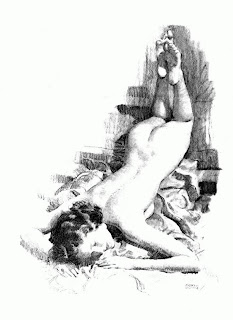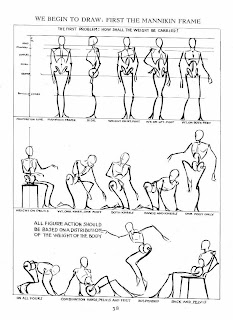I've had the book "Figure Drawing for all its worth" by Andrew Loomis for quite a while, after my unsuccessful attempt at life drawing last week I wanted to read it. So that's exactly what I've spent the day doing and I found it really interesting and useful. Andrew Loomis' drawings are fantastic and a great way to help figure out the proportions and methods of drawing the human figure, but just as interesting is how he talks about drawing and what is involved.
The first chapter talks to you as an artist, about your art procedures and the importance of understanding what you are drawing and why. I like the way Loomis connects with you through his writing and experiences and emphasis you within your art practise.
"I take this opportunity to impress upon you, my reader, how important you really are in the whole of art procedure. You, your personality, your individuality come first. Your pictures are your by-product. Everything about your pictures is, and should Be a little of you."
"It is really plain old courage, standing on ones's own feet and forever seeking enlightenment; courage to develop your way, but learning from the other fellow; experimentation with your own ideas, observing for yourself, a rigid discipline of doing over that which you can improve. I have never found a book that stressed the importance of myself as the caretaker of my ability, of staying heatlhy mentally and physically, or that gave me an inkling that my courage might be strained to the utmost. Perhaps that is not the way to write books, but I can see no harm in the author realising that he is dealing with personalities, and that there is something more important than technique. In art we are dealing with something far removed from a cold science, where the human element is everything."
These sections within the first chapter really resonated with me. Far to often I focus on the image itself I want to create and and not my own artistic learning process and digesting what I'm doing while drawing. Life drawing is especially hard for me in this sense. I haven't looked into the human body and understanding how it is proportioned or how it works, yet I try to draw the figure and ultimately struggle and do poorly. I want my drawing to be good, right now, and don't realise I need to understand what is in front of me before I can draw it. My drawings right now might not be fantastic but as long as I am learning from them I will improve as an artist.
Another I was inspired and surprised by was the way Loomis describes how other artists and even he had to start somewhere.
"Unfortunately most of us are mediocre when we start out; by and large, most commercial artists of outstanding ability had no more than average talent at the start. May I confess that two weeks after entering art school, I was advised to go back home?" This shocked me! Andrew Loomis has stunning artwork and a fantastic style, to think he was advised to quit is somewhat unbelievable. The point he is making however is encouraging, we aren't born awesome at drawing with an unique understanding of all we see, we must pratice, persevere and improve to get where we want to be. I doubt my ability at times but know if I push and continue to 'do over that which I can improve' I will advance as an artist.
"Unfortunately most of us are mediocre when we start out; by and large, most commercial artists of outstanding ability had no more than average talent at the start. May I confess that two weeks after entering art school, I was advised to go back home?" This shocked me! Andrew Loomis has stunning artwork and a fantastic style, to think he was advised to quit is somewhat unbelievable. The point he is making however is encouraging, we aren't born awesome at drawing with an unique understanding of all we see, we must pratice, persevere and improve to get where we want to be. I doubt my ability at times but know if I push and continue to 'do over that which I can improve' I will advance as an artist.
 The next chapter encourages you to being improving straight away, no fuzzy 'I'll do it tomorrow's here.
The next chapter encourages you to being improving straight away, no fuzzy 'I'll do it tomorrow's here."Start at once to take a new interest in people. Look for typical characters everywhere. Familiarise yourself with the characteristics and details that distinguish them." - "What gesture in relation to the emotion? Why is a certain childish face adorable, a certain adult face suspicious and untrustworthy?" - "This knowledge in time will become a part of you, but it can come only from observation and understanding. Try to develop the habit of observing your surroundings carefully." "Watch emotional gestures and expressions."
I have tried to draw people in public before, but it seems on such a basic level. I just looked at them and tried to replicate what I was looking at without really considering what I was seeing. The way the body moves, the body language, the facial expressions, what they are doing, who they are talking to or why. I wasn't really looking or understanding, just trying to replicate, and it generally didn't come out well.
Loomis also talks about the errors many art students tend to make when starting. I have been baffled by the way so many people, myself included, will draw figures incorrectly in the same way time and time again. We inherently know what people look like but when it comes to drawing them we all seem to start with the same mistakes.
"Consistently gray throughout - An overabundance of small fuzzy lines - Features misplaced in the head - Rubbed and dirty work - Too many mediums in same picture - The tendency to use tinted papers - Copies of movie starts - Bad arrangement - Highlights in chalk - Uninteresting objects" While I don't relate to all of those I can confess to some and they all add up to an incorrect image and a very frustrated me.
After the book's introduction it dives straight into drawing the figure and how to get it right. Firstly dealing with the importance of correction proportions in the figure and the difference between the male and female figures. This is the kind of think that needs to be commented to memory as it will subconsciously be used over and over from that point on in everything drawn. Continuing to keep the parts of the body in proportion when moved are the next thing covered, using arcs to show the realm of movement limbs have. "Proportion in relation to the horizon" and "Finding proportions at any spot in your picture" follow and I found these pages of particular interest. I find it difficult to keep people in proportion as they move around an image so the methods described are of importance to me to learn.
 Throughout the rest of the book Loomis continues to advance into harder and harder areas building on everything previously covered, from drawing the simple manikin frames and how the weight of the character is carried, through to detailing the frame, adding bulk and fleshing out the skeleton in all sorts of poses and perspectives. I was particularly interested in how in depth Loomis goes into understanding the basic structure of the human body, detailing the skeleton with names of bones, and then by naming all the muscles that make up our muscle groups. He advises learning them and later tests you to name muscles pointed on in a drawing. We, as artists, aren't expected to have a complete medical understanding of the body but knowing how its structure is made is essentially to drawing it correctly. Knowing how the bones and muscles sit under the flesh determines the way we look and how we can move and this is something I really don't have a clue about.
Throughout the rest of the book Loomis continues to advance into harder and harder areas building on everything previously covered, from drawing the simple manikin frames and how the weight of the character is carried, through to detailing the frame, adding bulk and fleshing out the skeleton in all sorts of poses and perspectives. I was particularly interested in how in depth Loomis goes into understanding the basic structure of the human body, detailing the skeleton with names of bones, and then by naming all the muscles that make up our muscle groups. He advises learning them and later tests you to name muscles pointed on in a drawing. We, as artists, aren't expected to have a complete medical understanding of the body but knowing how its structure is made is essentially to drawing it correctly. Knowing how the bones and muscles sit under the flesh determines the way we look and how we can move and this is something I really don't have a clue about. Another area I am rather clueless and which is covered very well in Loomis' book is lighting. He describes very well the way in which to approach lighting and how to define the areas of; highlight, half tone, shadow, reflected light and cast shadows. I know the basics of lighting but have never considered it as deeply as Loomis does. Even from the simple examples in the book I can see lighting and getting it right is an essential part of getting an image to be interesting an appealing. The way in which Loomis demonstrates lighting in his book is extremely beneficial to me and makes it simple to understand.
Reading Andrew Loomis' book has been fantastic. Its made me consider the human form in a completely different and much deeper way. I can't just look I need to understand, practise and perfect. There is many encouraging words in the book and helpful information to get me going. Figure drawing has always been like a big brick wall to me that I couldn't seem to get over. Hopefully with all this useful information and a wealth of new knowledge I can start to really understand what I'm seeing and realise it in artwork. This will undoubtedly extend into everything else I do on the course.
Thank you Andew Loomis.
Thank you Andew Loomis.






No comments:
Post a Comment